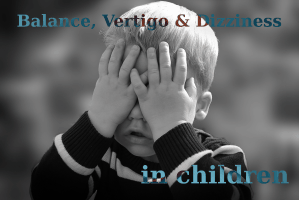Diagnosing Children with Vertigo, Dizziness, Balance Issues…
Although medical professionals have dealt with balance issues in children for a long time, the focus has probably always been more on adults. But there is a growing acknowledgement that dizziness, vertigo, and other balance issues are very important to diagnose in children as early as possible.
As with many conditions, vestibular disorders not only cause problems in the present, but also in the future. Developmental problems and learning disabilities are two of the issues that commonly go along with vestibular disorders in children. That means that they may suffer both physically and mentally, not to mention emotionally, if the problem is left undiagnosed.
There are many tools that specialists have today to help them come to an accurate diagnosis. For example:
- Questions: Talking with the doctor, and filling out questionnaires, can help the doctor understand medical history, family medical history, and related conditions (such as already diagnosed hearing loss). This step is critical.
- Simple clinical examinations: This includes basic testing such as having the patient stand with eyes closed and hands across their chest, or having the patient walk with eyes open or eyes closed.
- Rotational chair testing: This test places the patient on a chair which rotates at a certain speed. Special goggle measure eye movement after the spinning stops.
- Electronystagmography (ENG) Testing: Also used to measure eye movements.
- Video Head-Impulse Test (vHIT): An increasingly useful and easy test where goggles are places on the child’s eyes to measure eye movement. This, as with many tests, helps measure inner-ear problems.
- Hearing tests: A number of tests can be done for children and even infants. In fact, some doctors recommend that all newborns be tested for hearing loss.
These and many other tests can help narrow down the source and related issues to vestibular problems in children, such as loss of balance and dizziness.
Once all the tests have been done, what is the likely diagnosis? There is no one dominant diagnosis, but the most common is actually migraine. Child migraine may not look like adult migraine, and balance problems may be the only symptom you notice. But diagnosing and treating early can help avoid a host of problems.
Other common diagnoses:
- Benign paroxysmal vertigo of childhood: Also very common, and often difficult to differentiate from migraine.
- Inner ear malformations
- Visual disorders
- Head trauma
This is not an exhaustive list.
If you suspect balance or dizziness problems in your child, it’s very worth it to have them tested. The purpose of this article is not to give all the possibilities, but to give you some idea of the types of testing that may be needed.
Many parents may be concerned that testing will lead to unneccessary prescription drugs. The reality is, although parents need to be wise and cautious, there are many excellent treatments for dizziness and vertigo that can help avoid problems with learning and development, as well as further disorders down the road.
Sources and resources (for doctors and patients):
- Advances in Pediatric Vestibular Diagnosis and Rehabilitation
- Update 2015: Pediatric Vestibular, Balance, and Hearing Disorders
- Vestibular Testing (American Research Hearing Foundation)
- Pediatric Vestibular Disorders (Vestibular Disorders Association)
- Vestibular testing techniques in adults and children (pdf) (Neurology)
- Vertigo: A Clinical Guide
- The video head impulse test (Neurology)
- Balance disorders in childhood (International Journal of Pediatric Otorhinolaryngology)
- Migraine Treatment: Vestibular Rehabilitation
- 18 Reasons to Suspect Migraine in Your Child
